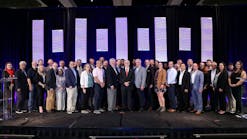Owners of industrial, commercial, and institutional boilers soon will be required to comply with new, stricter U.S. Environmental Protection Agency (EPA) air-emissions requirements. The new regulation, known as National Emission Standard for Hazardous Air Pollutants (NESHAP) for Industrial, Commercial, and Institutional Boilers, was issued in draft form by the EPA on April 29, 2010, and is expected to be finalized later this year. The regulation will affect thousands of boilers at facilities deemed to be major sources of hazardous air pollutants (HAPs).
Background
Section 112 of the Clean Air Act requires national emission standards for HAPs. The emission standards must reflect application of the maximum-achievable control technology (MACT). The EPA is tasked with developing MACT emission rules for specific industry groups, such as industrial, institutional, and commercial boilers.
On Feb. 26, 2004, NESHAP, commonly referred to as the Industrial Boiler MACT Rule, was finalized by the EPA. However, on June 8, 2007, the U.S. Court of Appeals for the District of Columbia Circuit issued a decision to vacate the Industrial Boiler MACT Rule, and the EPA was required to rewrite it. The EPA is accepting comments on the draft of the new rule, which must be finalized by Dec. 16. For more information, visit www.epa.gov/airquality/combustion.
Summary of the Rule
The Industrial Boiler MACT Rule applies to any industrial, commercial, or institutional boiler or process heater located at a major source of HAP emissions, which is defined as any stationary source or group of stationary sources located within a contiguous area and under common control that emits, or has the potential to emit, 10 tons or more per year of any single HAP or 25 tons per year of any combination of HAPs. The rule requires each boiler at a facility to meet emission limits or work-practice standards, meet operating limits, and demonstrate compliance on an annual and continuous basis.
Emission Limits and Work Practice Requirements
For all natural-gas- and refinery-gas-fired units and all existing units with a heat-input capacity of less than 10 MMBtuh, the rule establishes a work-practice standard instead of emission limits. The work-practice standard requires an annual tuneup for each natural-gas- and refinery-gas-fired boiler and a biennial tuneup for each existing boiler with a heat-input capacity of less than 10 MMBtuh.
For all other boilers (essentially all boilers that do not burn natural or refinery gas and have a heat-input capacity of greater than 10 MMBtuh), the rule sets emission limits for HAPs or HAP surrogates, including:
- Particulate matter (PM) as a surrogate for non-mercury metallic HAPs.
- Mercury (Hg).
- Hydrogen chloride (HCl) as a surrogate for acid-gas HAPs.
- Carbon monoxide (CO) as a surrogate for non-dioxin organic HAPs.
- Dioxin/furan.
The emission limits are based on a subcategorization of sources based on boiler status (existing or new), fuel type, and boiler type, as shown in Table 1.
Emission limits apply at all times, including periods of startup, shutdown, and malfunction. Also, facilities are allowed to comply with PM, HCl, and Hg limits by using emissions averaging, provided the average emissions are within 90 percent of the emission limit.
It is worth noting that the new Industrial Boiler MACT Rule is significantly more stringent than the original rule that was vacated. For example, the PM, HCl, and Hg emission limits proposed in the new rule are much more stringent than those in the original rule. The new rule establishes a CO-emission limit for existing boilers that was not required previously, and the dioxin/furan-emission limit did not exist in the original rule. Finally, the new rule does not contain the health-based compliance alternatives that originally were a key part of compliance for many facilities.
Demonstration of compliance with the emission limits is achieved through annual stack testing, continuous monitoring of operating limits, and recordkeeping/reporting.
Emissions-Testing Requirements
In addition to setting emission limits for HAPs, the Industrial Boiler MACT Rule sets standards for how sources are to demonstrate compliance with the limits. A facility will be required to conduct initial and annual stack-emissions tests on each boiler for PM, HCl, Hg, CO, and dioxin/furan to demonstrate compliance with the emission limits and establish each boiler’s operating limits, where applicable.
A facility can conduct stack tests less often for a given pollutant if the facility can demonstrate for at least three consecutive years that the emissions are at or below 75 percent of the limit. In this case, a facility could conduct a stack test every three years. If a stack test shows emissions of greater than 75 percent of the applicable limit, the facility must revert to annual performance testing. The reduced testing frequency does not apply to the dioxin/furan-emission limit and cannot be used if the facility is averaging emissions.
As an alternate method of demonstrating compliance with Hg- and/or HCl-emissions limits, a facility may conduct fuel-analysis testing. A fuel analysis would be required for each type of fuel burned and calculations performed to demonstrate that the pollutant concentration in the fuel is less than the emissions limit.
Operating Limits
In addition to conducting annual stack tests, a facility must demonstrate continuous compliance. To do so, the facility must monitor and comply with applicable site-specific operating limits established during the performance tests or fuel analysis. Site-specific operating limits vary depending on the type of pollution-control equipment employed by the facility. Operating limits could include maintaining an opacity of less than 10 percent or maintaining a sorbent injection rate 90 percent or greater than the injection rate recorded during the stack test.
Notification, Recordkeeping, and Reporting Requirements
In addition to demonstrating initial/annual and continual compliance, a facility must submit notifications, keep records, and submit reports.
Notifications include:
- Initial notification that an existing source is subject to the rule within 180 days of the rule’s publication in the Federal Register and that a new source is subject to the rule within 15 days of startup.
- Notification of intent to conduct a performance test at least 30 days prior to testing.
- Notification of compliance status within 60 days of completion of the initial compliance demonstration.
- Notification of alternative-fuel use by a natural-gas-fired unit within 48 hours of the declaration of a natural-gas curtailment or supply interruption.
Recordkeeping requirements include:
- Records demonstrating compliance with previously mentioned requirements.
- Records documenting deviations.
- Monthly fuel-use records.
- Documentation that solid waste is not being burned.
Beyond-the-Floor Requirement
A "beyond-the-floor requirement" is included for all existing major-source facilities housing affected boilers or process heaters that would require a one-time energy assessment by qualified personnel to identify cost-effective energy-conservation measures (in this case, "cost effective" means an item has a payback period of two years or less). The facility also must implement an energy-management program.
Impact on Industry
The EPA estimates that there are more than 13,500 boilers and process heaters located at major HAP sources that will be subject to the Industrial Boiler MACT Rule. A majority—approximately 11,500—of these boilers fire natural or refinery gas and, therefore, will be subject only to the rule's work-practice standards. However, there still are approximately 2,000 boilers that will have to comply with the rule's emissions limits.
The rule is expected to have the most significant impact on facilities that utilize coal- or biomass-burning boilers (solid-fuel-fired boilers). The EPA estimates there are approximately 600 coal-fired boilers and 400 biomass-fired boilers that will be affected by the rule. Many of the solid-fuel-fired boilers in compliance with the original 2004 rule will not be in compliance with the new rule's more stringent emission limits (Table 2). The stringent emission limits may force owners of solid-fuel-fired boilers to significantly upgrade their existing pollution-control equipment or consider switching to natural gas.
The PM limit will require most boilers to have a fabric filter as a particulate-control device. Of the approximately 600 coal-fired boilers, fewer than 200 utilize fabric filters. The HCl limit will require many solid-fuel-fired boilers to install scrubbers or inject an alkaline sorbent (hydrated lime, trona, etc.) ahead of the particulate-control device. The Hg limit also will require many boilers to install powdered-activated-carbon-sorbent injection systems ahead of the particulate-control device.
The CO and dioxin/furan limits will pose an additional challenge for most boiler owners because little emissions testing has been conducted to help owners understand the magnitude of these emissions or how best to control them. Therefore, total air-pollution-control upgrades for an existing solid-fuel-fired boiler could take many forms, including the retrofit of sorbent injection systems, a fabric filter, or a scrubber, at minimum. The cost of boilers will vary greatly, depending on size, fuel type, the extent and condition of existing pollution-control equipment, and retrofit complexity. Capital costs for these modifications could range from $1 million or less for a sorbent injection system to $5 million to $10 million or more for a fabric filter or scrubber. The EPA estimates that the average capital cost of retrofitting a coal-fired boiler with pollution-control equipment to meet emissions limits will be nearly $8 million, and the average capital cost of retrofitting biomass-fired boilers will be nearly $5 million.
Conclusion
Each compliance situation is unique. The only way to know what modifications may be necessary is to conduct a compliance study establishing baseline emissions information and comparing it with Industrial Boiler MACT Rule emissions limits. Because many facilities do not understand the magnitude of their emissions, compliance studies likely will include stack testing to establish baseline emissions, which a facility can use to assess compliance and, if necessary, develop a plan of corrective action.
Facilities must begin planning now. The Industrial Boiler MACT Rule compliance date is expected to be in late 2013 or early 2014. Generally, a compliance study takes six months, and air-pollution-control retrofit projects/fuel-switching projects can take 18 months to three years from the start of compliance planning through engineering and construction to startup.
Don Wolf is a principal with Burns & McDonnell Engineering Co. He manages the company's Energy Global Practice in its St. Louis, Mo., regional office. He can be reached at [email protected].
In related regulation news...
The EPA also proposed a rule on April 29 that would reduce emissions of toxic air pollutants from existing and new industrial, commercial, and institutional boilers located at Area Source facilities. An Area Source facility emits or has the potential to emit less than 10 tons of any single air toxin per year or less than 25 tons of any combination of air toxins per year. The rule would cover boilers that burn coal, oil, or biomass and establish standards to address emissions of Hg, PM (as a surrogate for non-mercury metals), and CO (as a surrogate for organic air toxics).









